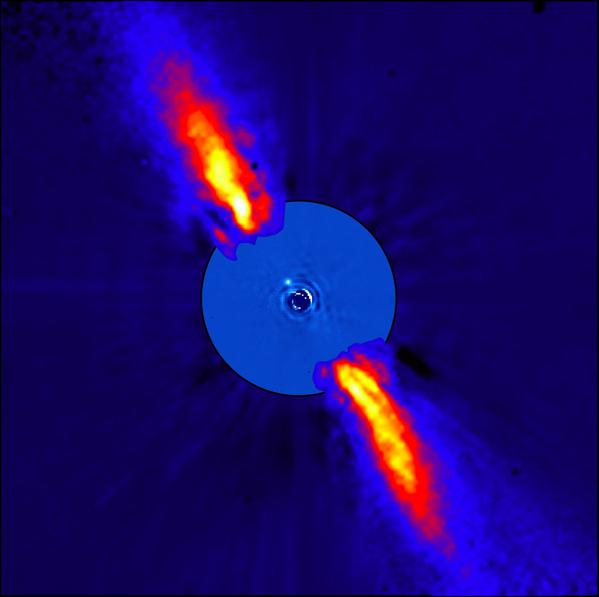This page describes an image beta Pictoris b
Caption:
This composite of two images shows the planet beta Pictoris b and a disk of material both of which orbit the young star beta Pictoris. Both are taken in infrared light. The inner image was one of the first pictures taken of a planet around another star (an exoplanet). This image was made using a technique called adaptive optics which removes the blurring effect of the Earth's atmosphere that spreads out a star's light. The star's light is then concentrated tightly enough that it can be hidden behind a blocking circle (shown here in black) called a coronagraph. The ripples around this are artifacts of the imaging process. Beta Pictoris b, a gas giant planet about twelve times the mass of Jupiter, appears as a dot above and to the left of the black circle.
The outer image shows the thermal emission from the warm disk of material surrounding the young star beta Pictoris. As we are viewing this disk edge-on it appears as a line. This disk of gas and dust provided the material to form beta Pictoris b.
Credit:
ESO/A.-M. Lagrange et al. Credit Link
Related glossary terms:
Adaptive Optics
, Exoplanet
, Planet Formation
Categories:
Exoplanets & Astrobiology
License: Creative Commons Attribution 4.0 International (CC BY 4.0) Creative Commons Attribution 4.0 International (CC BY 4.0) icons
The media file captions presented on the OAE website were written, translated and reviewed by a collective effort from the OAE, the OAE Centers and Nodes, the OAE National Astronomy Education Coordinators (NAECs) and other volunteers. You can find a full list of credits for our translation project here. All media file captions are released under a Creative Commons CC BY-4.0 license and should be credited to "IAU OAE". The media files themselves may have different licenses (see above) and should be credited as listed above under "credit".
Captions in Different Languages:
Caption: Questa composizione di due immagini mostra il pianeta beta Pictoris b e un disco di materiale che orbitano attorno alla giovane stella beta Pictoris. Entrambe le immagini sono riprese nella luce infrarossa. L'immagine interna è una delle prime di un pianeta intorno ad un'altra stella (un esopianeta). L'immagine è stata realizzata con una tecnica definita ottica adattiva, che elimina l'effetto di sfocamento dovuto all'atmosfera terrestre che diffonde la luce della stella. La luce della stella viene concentrata a sufficienza da poter essere nascosta dietro uno schermo circolare (in nero) chiamato coronografo. Le increspature intorno a questo cerchio sono prodotte dal processo di analisi dell'immagine. Beta Pictoris b, un pianeta gigante gassoso di massa circa dodici volte superiore a quella di Giove, appare come un punto in alto a sinistra del cerchio nero.
L'immagine esterna mostra l'emissione termica del disco caldo di materiale che circonda la giovane stella beta Pictoris e si presenta come una linea poiché lo vediamo di profilo. Questo disco di gas e polvere ha fornito il materiale per la formazione di beta Pictoris b.
Credit: ESO/A.-M. Lagrange et al.
Related glossary terms: Esopianeta , Formazione dei pianeti , ottica adattiva Caption translation status: Approved by a reviewer
Caption translators: Giuliana Giobbi
Caption reviewers: Silvia Casu, Rosa Valiante, Raffaella Ferretti, Anna Wolter









